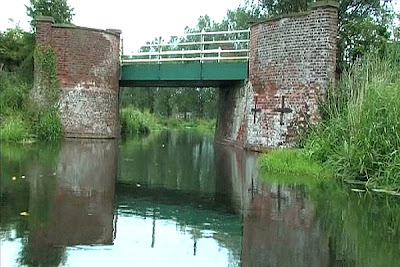"Black Shuck" - "The Hound From Hell" is a well known East Anglian legend - a large black dog with eyes that burn like red fireballs. He roams the coastline and the marshes right across Norfolk and Suffolk. Anyone who looks into those flaming red eyes will be dead within twelve months, according to the legend.
In September 2011 we loaded the cameras and headed for Suffolk to follow in "Shuck's" paw prints.
"Shuck's" first recorded appearance was in Bungay, Suffolk, on August 4th 1577. During a violent thunder storm a large black dog ran into St Mary's church and attacked and killed two of the congregation. A third man survived, it was said his wounds resembled scorched leather rather than wounds consistent with an animal attack.
It was also claimed that the dog's claws left scorch marks on the church doors of the North porch. Unfortunately any evidence to support this was lost when the church was badly damaged by fire in 1688.
A few miles away in Blythburgh a similar attack took place during a violent thunder storm. Again it was reported that a large black dog ran into the church and attacked members of the congregation, a man and a boy were killed. During the attack the steeple was struck by lightening and part of the masonry crashed through the roof of the nave. Once again Shuck's claws left scorch marks on the church doors, these marks are still clearly visible.
Earlier the same day a local man was chased by a large black dog, this fellow was able to reach the safety of the parish church before the dog could attack him. Again scorches and scratch marks were left on the doors of the church.
Although phantom Black Dogs have been reported since Roman times the events in Suffolk in 1577 gave a perceived credibility to "Black Shuck's" existence. The "Hound from Hell" tag originated from the belief that Shuck was actually the devil who appeared in the form of a black dog. If the story had ended there the legend might have been relegated to the status of an "Old Wives Tale" but over the last four centuries there have been many sightings of the black dog. From Suffolk to North Norfolk people have claimed to have seen the dog with flaming red eyes.
In 1890, on Yarmouth beach, a young lad was preparing to swim in the sea when a large black dog approached him. The boy entered the water and began to swim - the dog followed. For some time the two of them swam together much to the amusement of the teenager. The young lad was enjoying the swim with his new friend but as he was beginning to tire he decided to to turn back to the beach. The black dog snarled and barred the way, several bites to the boys feet and back forced him further out to sea. He was practically exhausted when a fishing boat spotted them. Assuming the boy and his dog were in trouble the fisherman rowed over to assist them. They hauled the semi conscious youth into the fishing smack and were horrified to see deep wounds in his back, shoulder and feet. As they made for the shore they watched the black dog swim out to sea until it was out of sight.
A stormy night in North Norfolk in 1980 a holiday maker stopped to buy a pint of milk at a village store. He left his young son in the car while he nipped into the shop. A few minutes later he emerged with the milk just in time to see a large black dog disappear into a copse on the opposite side of the road.
Inside the car the child sat frozen with fear - he told his father the dog had glowing red eyes and had tried to get into the car. The following day the father found large muddy paw prints on the bonnet and the back window of the car.
Between West Runton and Overstrand there have been so many sightings over the years the area is called Shuck's Lane. Sir Arthur Conan Doyle who was convalescing in Cromer would often dine at Cromer Hall with the lord of the manor. He heard many stories about the black dog from Baskerville the lord's coachman. Soon after his stay in Norfolk Sir Arthur wrote "Hound of the Baskervilles", without doubt Shuck was the inspiration.
I am ecstatically happy to report that we saw no trace of the "Hound From Hell" so we have had to recruit a large black dog to appear in the film on "Shuck's" behalf. To say Shuck does not exist would be the logical reaction for most people. But next time you find yourself walking along a lonely Norfolk lane in the fading light, you might have to ask yourself, is it the North wind howling or could it be............
Authors Footnote 8th February 2012.
Sightings of a black Puma or Panther loose on the outskirts of Norwich yesterday. This is the latest in a series of sightings of what is definitely a large black animal roaming the Norfolk countryside.
These sightings have been reported regularly over the years but so far no evidence has ever been found. One would expect to find evidence of kills or paw prints if there was a big cat on the loose but so far nothing. What if.............?


















































